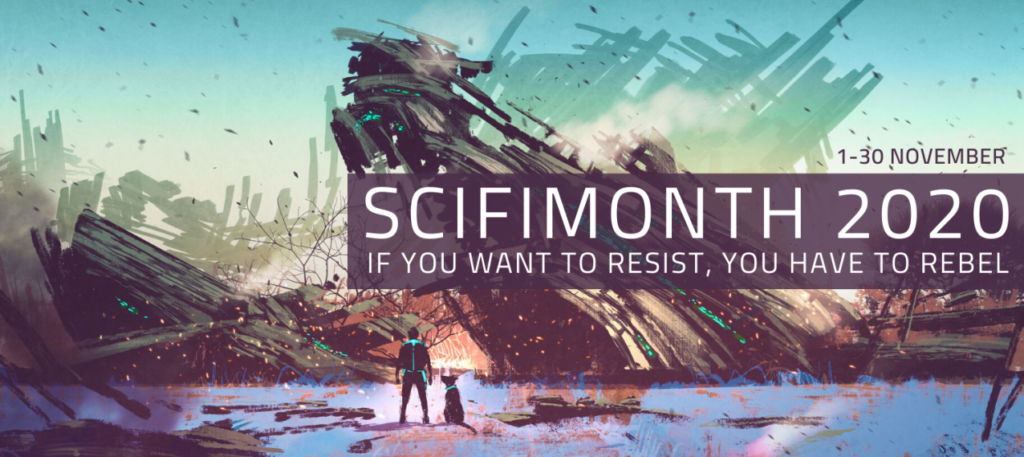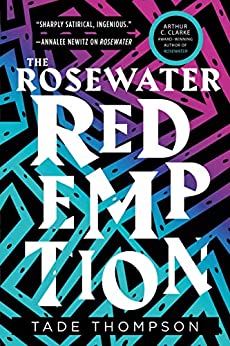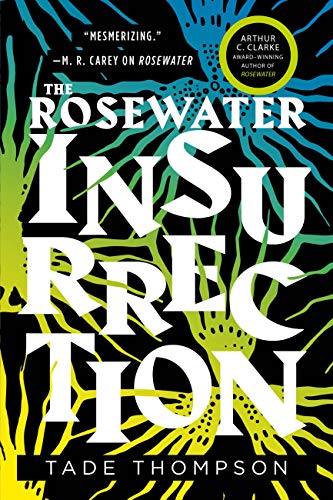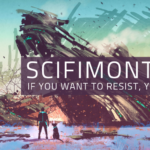
Tade Thompson begins Rosewater Redemption, the concluding volume of his Wormwood trilogy, with a kind of fugue, an almost musical prelude in which the major characters re-enter the story, each changed by what has gone before. We see Rosewater in all its multiplicity, through the eyes of each character, as a city in time, experienced through the transforming power of imagination.
The city arose around the alien entity known as Wormwood that crashed to Earth in 2012, eventually emerging in Nigeria. The city’s destiny, like that of humankind, is linked to the alien-created medium known as the xenosphere.
“The xenosphere is a thoughtspace connecting all humans to each other by way of alien bioengineered neurones in the atmosphere. The aliens use it to store the entire history of mankind, including the biological history, with contextual feelings, everything.”
Rosewater Redemption, Kindle edition, p. 87

Kaaro, who started out as a thief then became a reluctant government agent to combat the aliens, returns from the earlier books with a new sense of who he is. As his resurrected mentor Nike tells him, he is now concerned for the first time in his life about something bigger than himself, saving humanity from the aliens. But I think the primary role in Rosewater Redemption belongs to Oyin Da, once known as the Bicycle Girl, who travels at will between dimensions and timescapes:
“I am Oyin Da, the improbable, the Bicycle Girl. I am an artist; history is my clay. Follow me closely. There will be turns, sudden shifts of perspective, hurricanes without warning.”
Rosewater Redemption, Kindle edition, p. 2
This almost prophetic voice draws the narrative together. In the earlier books, Oyin Da was a shadowy figure, but in Redemption we hear her backstory. It is one set in the heart of Nigerian culture. We learn from her birth, naming and childhood in the traditional village of Arodan how she evolved into the being who flows through time and space.

Her journeys and transformations, however, often blank out her memory temporarily. At one point, she asks of Nike and Junior, her wife and daughter respectively in the xenosphere:
“Am I… dead?” I look to Nike. She has a pained expression on her face. “No. … It’s more like you have never really been alive.” “Are you saying I’m some kind of mimic? A doppelgänger?” “No. You, me, Junior, none of us have ever been alive. We are ghosts in the xenosphere, repetitive information patterns.”
Rosewater Insurrection, Kindle edition p. 86
What that means becomes clearer as the story unfolds through Oyin Da’s extraordinary adventures. But in this remarkable scene, a kiss brings back her memory, and we are off on the central action of the book.
Through it all the xenosphere plays a key role. It is the medium that enables the aliens, known as Homians, to track and record human minds and memories, the whole history of humankind, and to gradually substitute alien cells for human ones.
It is also the medium through which Oyin Da and Kaaro can travel to reshape events. As Kaaro thinks of it: “whoever controls the xenosphere controls thoughts, and thoughts create reality.” The universe is a construct “part sensory information, part memory, part imagination.”
So much of the battle to save humanity has to take place in this construct through the power of imagination, along with memory and some manipulation of information. Even more than in the previous two novels of this trilogy, the crucial fights depend on what happens in the xenosphere through Oyin Da’s shifting in time and memory, and Kaaro’s ability to reach into alien space.

As Rosewater Redemption begins, there is no dome shielding the alien world from the surrounding city, and the healing of humans takes place constantly. As soon as a human is injured the healing begins. That is because the human bodies are being prepared to become vessels for the alien minds that are stored at far distant locations, space stations orbiting the failed planet the aliens call Home.
At this stage of Wormwood’s development, the Homians, have brought their chief scientist, Lua, to earthly existence in human form. She works with Koriko, who was Alyssa in Rosewater Insurrection, the first human to be fully integrated into the xenosphere. She has replaced Anthony, the first human embodiment of Wormwood, and is regarded as a god because of the continuous healing powers emanating from the alien-dominated earth in the midst of Rosewater. Lua and Koriko have built a structure known as the Honeycomb where they carry out the grisly business of outfitting the human dead with Homian minds.
The Mayor of Rosewater, Jack Jaques, had worked out a truce at the end of Rosewater Insurrection which allowed Homians to perform these transformations on the human dead. But his brilliant partner, Hannah, a lawyer, blows up the premise of this arrangement by questioning whether any human is really dead in Rosewater.
In a basic sense, even if memory of who they were is lost, they are still self-aware and distinct from their environment. Her work ignites a fury in Rosewater as people rebel against the use of their “dead” loved ones for alien minds.
Thompson shows us the clash between species from multiple angles and keeps deepening our understanding of the complexities of the interaction. Yet, like the multiple possibilities of quantum functions, eventually they collapse into the basic clash between humans and aliens.
So we see Koriko dedicating herself with increasing single-mindedness to processing dead humans into revivified beings with Homian minds.
Lora, the android construct who has served as the faithful assistant to Rosewater’s mayor Jack Jacques. She views the human-Homian interaction without emotion but becomes more and more curious about human reactions.
The mayor is trying to preserve the transactional truce with the Homians that he has arranged without looking much beyond his own position and potential threats to the deal he has worked out. Though he is warned several times by The Tired, the shadowy group of reformers who are trying to rid African politics of corruption and who mentored Jack, he persists in his narrow view of trying to hold onto a construct of political survival that doesn’t seem destined to survive.
His wife Hannah brilliantly analyzes the legal status of the humans in a world where they can’t really die since the healing atmosphere of Rosewater is now working all the time. Aminat, Kaaro’s lover, is the top cop of Rosewater and tries to keep as many human corpses away from Koriko as she can by obliterating their physical bodies, a hard task since the healing process begins as soon as a wound is inflicted.
The stories of these and many others are brilliantly interwoven in a mesmerizing tale that moves you, as if in a spiral, toward an inevitable yet surprising climax. Thompson’s evocative prose probes deeply into the nature of imagination and the very way we experience life as beings changing through time. Rosewater Redemption is a brilliant conclusion to a remarkable trilogy.




Leave a Reply